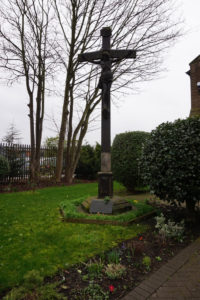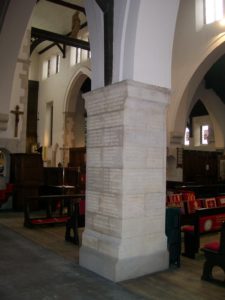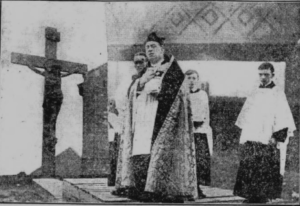My name is Paul Bishop. I have lived and worked in Hull, for the last 30 years.

My interest in the Hull Memorial started in the mid 1980’s, when I lived in Folkestone Street, off Sculcoates Lane, in Hull. While waiting outside a white, telephone box (this was before mobile phones!), I noticed the ‘Great War’ memorial, at the entrance of St Mary’s Church, on Sculcoates Lane. There stood in the church yard, a life-size, ‘Crucified Christ’, carved from solid oak, erected in memory to those lost in the ‘Great War’. Inside the church, were the names of 175 men from the Sculcoates Parish, inscribed on a stone pillar, who had died in the First World War. They were just a list of names and no other details.

This seemed an extraordinary, high loss of life, from one Parish. I was curious to find out more about these names. Who were these men, what did they do, where did they live and what happened to them and their families? As many of the houses surrounding the Church were built before the First World War, I was interested to see where the men may have lived in the area?
Answering these questions was difficult. There was no internet, or easy access, to online records, then. I spent hundreds of hours of spare time, in between work, visiting local libraries, researching electoral registers, reading local newspapers, books and military diaries. Copying records by hand was slow, and accessing other records was expensive.
However, as I became more experienced in retrieving and recording information, my research quickened and a fascinating story unfolded of Hull during the First World War. I learnt about Hull, its history and the lives of ordinary people, swept up in a World conflict. I discovered that not only had the First World War had a devastating impact on the Sculcoates area, but the same story was replicated all across Hull. Therefore what started initially as a hobby, to trace a few names on a local war memorial, became over time, a major project, to record all those from Hull that died in the First World War.
However, to really remember the dead it became necessary to find out more about them. War memorials needed to be more than just a list of names. The digital age now allows us to touch a name on a memorial, and produce a photograph, or share a link, to a personal story, that we can all connect with. I therefore developed the ‘Kingston upon Hull, Memorial 1914-18’, to make all local memorials more interactive. It was a journey that took me on many paths, exploring memorials, churches, workplaces, and cemeteries. I even visited the battlefields abroad where Hull men had fought and died.
The name of the ‘ww1hull.com’ website is easy to remember. It does what it says, organising all the information on Hull, in World War One. It records all the details from Hull’s many First World War memorials, and arranges the names of the dead by street. It links each name to a satellite map, so it can be seen where they lived, and every day, remembers the names of Hull men, who died on this day during the War. This enables the reader to assess the impact of the war on Hull communities.
All the names of the dead are listed to emphasize their existence as individuals. Where possible, some personal information has been provided, on each man, to highlight the enormity of their loss, to those that they left behind..
The reader can search the database, in may ways, by name, by street, by regiment, or the date died. They can also discover more about Hull, during the ‘Great War’, on a variety of links to other sources.
My website is free to use. There are no charges or fees required, to access this information. My many years of research, are my gift to the City, as Hull is my home and its’ people have been good to me. It seems appropriate to release this information, now in 2014, in line with the Centenary Anniversary, of the start of the First World War. I also hope it will increase our understanding of Hull’s history, and complement the wider work, of Hull as the City of Culture in 2017.
I must sincerely thank and acknowledge all the help past and present, from individuals and organizations, that lent support and provided information to this work. They are many and they know who they are. In particular, I would like to acknowledge the work of Malcolm and Mary Mann, who many years ago, took it upon themselves, to visit memorials and record their details by hand. I never met them, but their efforts inspired this work, and I hope they would approve. I also thank Chris Smith, from ‘virtual riders’, who designed this site, and the ‘Goodwin Centre’ who first took an interest in my work. Also, all the sterling assistance, provided by Hull City Council’s Library staff; the Hull History Center; the Commonwealth War Graves Commission; and the Imperial War Museum. However, this is just the start. It is hoped that in time, more records, stories and photographs will be added to the website, in order to make this a comprehensive and accurate record of Hull in the First World War.
Every person recorded on the Hull Memorial has their own unique story and there are over eight thousand stories to tell. The potential of all these people was lost to the world, but they are remembered here, now.
Paul Bishop
WW1Hull@yahoo.com

In Memory of my Grandmother, Phyllis Gladwin, who helped raise me, and her Grandfather, Petty Officer, William Littleford, 14147, Royal Navy, HMS ‘Clan McNaughton’, lost at sea, 3rd February 1915, aged 55, (No Survivors): her Uncles, Gunner, Edward John Parker, 940567, Royal Field Artillery. ‘D’ Bty, 4th (London) Howitzer Bde, died of wounds 9th July 1916, aged 18 years, buried Warlincourt Military cemetery, France; and, Private, Ernest Raymond Middleton, 40662, Middlesex Regiment 12th Bn, killed 15th January 1917, aged 19, buried Puchervillers Military cemetery, Somme, and her husband, Cpl, Frank Edward Nash, 1460102, Royal Air Force, killed 30th August 1944, aged 35, buried Les Authieux Churchyard, France.
Also to other relatives:-
Private, Leonard Edward Nash, 225101, Royal Fusiliers (City of London) 1st Bn, died of wounds 21st July 1917, aged 19, buried Wimereaux.
Sgt, Herbert James Clarke, 358, Royal Fusiliers 10th Bn, killed in action, 10th July 1916, buried Becourt cemetery, Somme.
L/Cpl, Sam Lister, 15200, West Riding regiment 10th Bn, killed in action ,10th July 1916, aged 28, Thiepval, Somme
Private, Joseph Lister, 205365, West Riding Regiment 2/5th Bn, died of wounds, 22nd November 1917, aged 22, Rocquigny cemetery, Somme.
Private, Arthur Lister, 161817, West Yorkshire Regiment 10th Bn, killed in action, 23rd April 1918, aged 22, Forceville cemetery, Somme.
Private, Harry William Bishop, 1624, Australian Infantry, AIF, 44th Bn, killed in action, 11th October 1917, aged 42, Ypres (Menin Gate).
They gave their tomorrow, for my today.
Author and Researcher
Dear Sir
I have in my possession a photo of a bomb dropped by a zeppelin on a railway line in Hull. It shows several people standing around the
unexploded bomb including one of my great uncles scouts. I have an autograph book belonging to one of his daughters with the Hull Recruiting Office Stamp on one of the pages with many names written around the stamp. Also in the book is the autograph of John Cunningham VC on his wedding day in 1917. I have a postcard written by my grandfathers’s brother where he refers to his scouts doing coast and bridge work (acting as lookouts) and he refers to Mad Billy (the Keiser). I also have a medal presented by Sir Robert Baden to my great uncle in 1916 in Hull. It is a Swastica with the scout emblem in the centre. How ironic?
The Hull “Sportsmen” were the 12th East Yorkshire Battalion
So much time and effort to remember all these men. You have done them proud. I was researching Balfour street where I grew up in the 50s and was shocked and amazed by the sheer number of those killed from just one small street in Hull. I now live in France and we visit the Ww1 cemeteries whenever we go to Zeebrugge en route for visiting Hull a very sobering experience
Thank you you will have helped so many people
dear Paul you have done a wonderful thing to bring all the heroes of WW1 together in one place well done. I have a question Harry Barr lost at The Somme, you said he has a brother Tom BUT I cannot find him anywhere in records. could you please let me know how you found Tom Barr. Thank you and many thanks for the hard work you have put in over the many years.
Hi
I find it so interesting to read the names on
the WW1 memorial sited in St Mary’s church
Hull, I have tried to read the inscriptions on the online photo’s but sadly I cannot see my Great uncles name Robert Elsom he died of wounds on 22nd March 1918 aged 19 in France, his family all lived in the Sculcoates area (Stafford Street) at the time.
Robert joined up at the age of 15yrs 6 months
he was transferred to the 16th Battalion Royal Scots Guards (Lothian Regiment)
I just wondered if all of Hulls WW1 war dead
were remembered on memorials.
Regards
Mrs J Wright
Just linked your details for the Wilkinson boys to https://astreetnearyou.org/person/461589/Private-Arthur-Fredrick-Wilkinson and the Everyone Remembered pages . I’m adding more links to the AStreetNearYou site listing where they will eventually be visible.
I think the website you have created is wonderful. I know what it is like putting together historical facts as I have been writing about my mother and father for over 20years and am only just finishing it. I will send you more information on George Robert Godfrey and Charles Godfrey, who you have down as his brother. They were my grandmother’s brothers from Horace Avenue. A great website.
Hi Paul
I am the great great niece of John (Jack ) Cross who died in the First World War and came from Walkington. Can I ask you to change the date of his death please. He died on 11/4/1918 . I have the war records so I know the date is correct. Thank you. And I just wanted to say also your articles are very interesting and informative.
Hi Paul, I found an old photo of my Great uncle, Thomas Glenton of Poplar Terrace, Rosamond Street, Hull. He was in uniform so I googled him and ended up with lots of information thanks to this website. I now know he was in the PALS and was KIA in the battle of Vimy, Oppy Wood aged 21 having survived Egypt and the Somme. Thankyou for your contributions in helping me discover part of my history. Strangely I live in the Dalton Estate where the some of the pals were trained. I am currently trying to get information about the barracks here.
Regards
Lynne
Hi Paul
I came across your site this evening, I looked for my Grandad, Peter Giblin Service No 61205, Some of your information is incorrect his Father was Timothy Giblin (1856 – !922) and his Mother was Kate Giblin (Nee Catherine Higgins 1855 -1899)
In 1901 at 12 Simons Terrace, St Marks Street, Peter was staying with his uncle Charles.
I know you have put a lot of work into this site which is very interesting and you cannot be expected to be 100 correct as the people you are researching you do not know and it would take to long on each person.
Regards
Ron Urquhart
Hi Ron, I have now made the amendments. Thank you for helping me keep the website, interesting, relevant and accurate. Much appreciated.
Paul can you tell me where Sutton Bank was please .
Just reading a piece in it now
……the newcomers would work for lower wages than Hull workers, and they crowded into miserable courtyards and tenements in often squalid conditions. In Howard’s Row in Sutton Bank, 300 people lived in 20 small houses. !!!! Would love to know where this is ? Have a feeling it’s sculcoates area maybe close to Wincolmlee but I’m guessing. I’m from Hessle Road myself. And just writing about crime on Hessle Road at ghe mo. 1880 to 1900
Sutton Bank, Dansom Lane, Hull. It included other Terrrace’s like New Parade. Now demolished